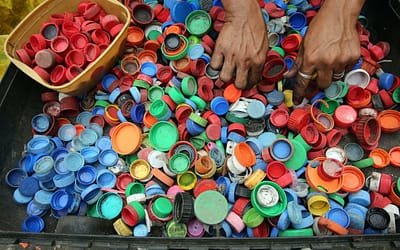This post was originally published on Colossal
“The Two Walls” by Alejandro Cegarra, The New York Times/Bloomberg. A migrant walks atop a freight train known as “The Beast.” Migrants and asylum seekers lacking the financial resources to pay a smuggler often resort to using cargo trains to reach the United States border. This mode of transportation is very dangerous; over the years, hundreds have fallen onto the tracks and have been killed or maimed. Piedras Negras, Mexico, October 8, 2023. All images courtesy of World Press Photos, shared with permission
From Israel’s ongoing assault leaving the people of Gaza in horrific destitution to a record-breaking surge of migrants at the U.S.-Mexico border, the last year has seen incredible devastation around the globe. The 2024 World Press Photo contest gathers a profound and illuminating collection of images that approach myriad crises with compassion and clarity.
This year’s competition garnered 61,062 entries from 3,851 photographers in 130 countries. The winning images include a striking black-and-white shot of a man mid-step as he perilously crosses from one moving train car to the next in Piedras Negras and a portrait of an Afghan woman resting on a couch amid the desolate mountain landscape at a refugee camp near the Pakistan-Afghanistan border.

“Afghanistan on the Edge” by Ebrahim Noroozi, Associated Press. An Afghan refugee rests in the desert next to a camp near the Torkham Pakistan-Afghanistan border, in Torkham, Afghanistan, Friday, November 17, 2023. A huge number of Afghans refugees entered the Torkham border to return home hours before the expiration of a Pakistani government deadline for those who are in the country illegally to leave or face deportation.
One of the few hopeful submissions, Jaime Rojo’s “Saving the Monarchs,” looks up at innumerable butterflies fluttering among the trees of El Rosario sanctuary in Michoacán, Mexico. Due to encroaching industry and a changing climate, the insect population had been in sharp decline since the 1990s, although international efforts have reversed the downturn by more than 80 percent. “This beautiful yet powerful story—a symbol of unity in polarized times—offers a solutions-oriented perspective on environmental change and conservation,” a statement about the series says.
In 2023, 99 journalists and media workers died, about 75 percent of whom were killed in the Israel-Hamas war. It was one of the deadliest years on record, with 2024 already approaching that number. “Work, for a news photographer, can be a dangerous place,” the organization says. “Unlike other journalists, news photographers must be where the story is happening— which might be a war zone, a humanitarian disaster, or somewhere free and open media is not welcomed.” The collection, therefore, is also a stark reminder of the people behind the lens and the risks they take to share essential information.
World Press Photo will bring the winning images to more than 20 cities in the coming months, and if you’re interested in diving deeper into the stories behind the shots, pick up the 2024 yearbook.

“Israeli Airstrikes in Gaza” by Mustafa Hassouna, Anadolu Images. A resident of al-Zahra walks through the rubble of homes destroyed in Israeli airstrikes. The strikes hit around 25 apartment blocks in the university and residential neighborhood. At the time of writing, March 4, 2024, Israel’s attacks on the occupied Palestinian territories during the Israel-Hamas war had killed some 30,000 people and injured more than 70,000. Gaza City, Gaza, October 19, 2023.

“The Edge” by Zishaan A Latif. Bengali-speaking Hindus and Muslims help each other shift shops from the edge of the Brahmaputra river at the Tarabari ferry point. The shifting is done in anticipation of the erosion of land that occurs with each monsoon season, which is often devastating for residents as they are forced to constantly adapt to a changing landmass each year. Tarabari, Bahari constituency, Barpeta district, Lower Assam, India, June 15, 2023.

“Kakhovka Dam: Flood in a War Zone” by Johanna Maria Fritz, Ostkreuz, for Die Zeit. A peony bush submerged in floodwater on an island in the Dnipro River. The city’s proximity to the frontline hampered rebuilding efforts. Kherson, Ukraine, June 7, 2023.

“Saving the Monarchs” by Jaime Rojo for National Geographic. Butterflies stream through the trees in El Rosario, a sanctuary within the Monarch Butterfly Biosphere Reserve in Michoacán, Mexico. Migrating monarchs winter in the same oyamel fir groves that sheltered earlier generations.

“Red Skies, Green Waters” by Adriana Loureiro Fernandez for The New York Times. Neighbors play Animal Lotto under a sky lit by one of the world’s largest gas flares. Punta de Mata, Venezuela, November 5, 2022.

“Fighting, Not Sinking” by Eddie Jim, The Age/Sydney Morning Herald. Kioan Climate Emergency Declaration meetings on Kioa Island, Fiji. Kioa island resident Lotomau Fiafia and his grandson John, Lotomau was born on the island in 1952, he saw the changes of the shoreline in the past decades, picture of him standing in the water roughly where the shoreline used to be when he was young, and now its up to his chest. August 8, 2023.

“Pollution in the Cileungsi River” by Arie Basuki. Residents catch fish on the Cileungsi River, which is polluted by factory waste at Curug Parigi, Bogor, on August 8, 2023. In the dry season, when other areas of the river experience drought, the Cileungsi River has now been polluted with toxic and dangerous industrial waste, which is pitch black, foamy, and smelly. As a result, the supply of clean water, the main water source that comes from the Cileungsi River in the Bekasi area, is disrupted.

“No Man’s Land” by Daniel Chatard. Police and RWE energy company security officers block activists belonging to the Ende Gelände action alliance, who have entered the Hambach open-pit mine. Kerpen, Germany, November 5, 2017.
Do stories and artists like this matter to you? Become a Colossal Member today and support independent arts publishing for as little as $5 per month. The article With Few Glimmers of Hope, the World Press Photo Contest Documents War, Migration, and Devastation appeared first on Colossal.





0 Comments